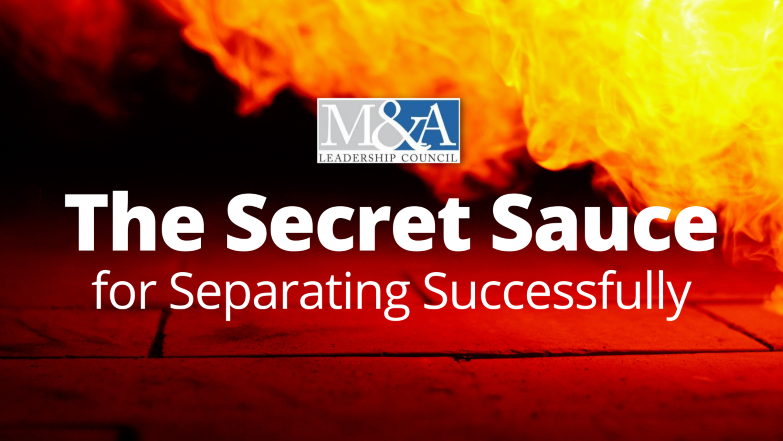
Mark Herndon, Chairman of the M&A Leadership Council, shares Part Two of this series covering key requirements in supporting the buyer post-close and optimizing the Seller’s remaining business for maximum value when divesting a business.
In our first installment, titled, “Separation for Success – Divesting for Maximum Value,” we covered how to master the divestiture process by upgrading your pre-sale planning approach and the importance of playing both “offense and defense” when preparing a business to be divested. Today we dig into the vital need to optimize the seller’s remaining business post-divestiture.
Separating for Success: The Secret Sauce
The 3 Mission-Critical Ingredients for Divestiture Success
Let’s face it – once a divestiture sale closes, there’s a natural tendency for executive focus and accountability to immediately shift to other urgent priorities and let the seller’s remaining post-sale business continue on a “business as usual” basis. Unfortunately, that’s a huge mistake – as the real value creation phase is only just beginning.
There are three mission-critical requirements at this phase of every divestiture that, if done well, will take your results from good to great, but if done poorly, there will be hell to pay with analysts and stakeholders who fully expected more.
Speaking of hell, we must first acknowledge the sheer fatigue that the seller’s divestiture team will be experiencing at this point. Executing well across the entire divestiture lifecycle can be hell.
But as Winston Churchill once famously said, “When you are going through hell, keep going!” That’s exactly what the best divestors do post-closing – they keep going by relentlessly driving value in these essential ways:
1.) Strategic Use of Net Proceeds
Frankly, this step is a given… nothing more than table stakes. If you reinvest divestiture proceeds to acquire faster growth and higher-margin businesses or strategic, transformative technologies; reduce debt, conduct share buy-back programs and the like, you will meet – but not exceed -- analyst expectations.
2.) Optimization of Separation and Transition Costs
Industry studies vary widely based on multiple factors, but most sellers should anticipate spending 1-2% of total enterprise value on transaction costs alone. Typical estimates include only the pre-close and post-close fees and direct spend (not overhead allocation or budgeted payroll!) required to shop and close the deal – and to support the seller’s baseline TSA requirements. Separation costs substantially above typical industry norms will invariably attract analyst scrutiny.
A more complex and often perplexing challenge is that of stranded costs. These costs consist of personnel, infrastructure, systems, applications, vendor contracts and overhead costs that are no longer needed as a part of the seller’s organization at the termination of the TSA, thus “stranded.” The challenge is that most sellers defer or delay thinking about or planning effectively for this enormous risk until far too late in the TSA, then they screw it up. This is further complicated by the harsh reality that due to the seller’s reduced revenues immediately post-sale, the sustained TSA and stranded costs disproportionately impact costs as a percentage of sales, once again coming to the attention of analysts and potentially impacting share price performance. This doesn’t just take expert financial engineering – it takes highly attentive leadership and superb change management to anticipate, plan effectively, set expectations, and genuinely do what’s right to take care of those seller employees that will no longer be needed after the TSA terminates.
3.) Seller Performance Improvement Initiatives
Industry studies generally indicate that only about one-third of all sellers accomplish the one thing that is almost single-handedly responsible for driving the biggest and most important post-closing financial and operating performance improvements. As stated simply by one recent M&A Leadership Council training participant, “With divestitures, first you have to transition – but then you have to transform.” To take your value-creation results from status quo to “game-winner” status, once past closing stage, divesting executives must aggressively and strategically drive the right portfolio of internal transformational efforts. The kicker? Data shows you typically have no more than 6-24 months post close for executing these transformation initiatives to fully capture intended value.
The nature and scope of performance initiatives vary widely by company and industry. For one, it may be digital transformation, automation, and CX. For others, it may be further restructuring and business turn-around. Or, it may be outsourcing non-core services and doubling down on product innovation for yet others. Regardless of which performance improvement initiatives your company may need most, this strategy is endorsed time and again as “how the best divest.”
****
Did you miss Part One of this blog?
If you missed Separation for Success: Divesting for Maximum Value, read it now. Ready to take the next step in divesting for success? Register for our upcoming training, The Art of M&A® for Divestiture & Carve-Out Leaders / Live-Online, May 16-18, 2023.
______________________________________________________________________________
Mark Herndon, serves as Chairman and CEO of the M&A Leadership Council, and specializes in M&A strategy, due diligence, integration management, enterprise communications and leadership during periods of disruptive change. The M&A Leadership Council is an educational consortium of global professional service firms, experts, and corporate practitioners in the art and science of mergers, acquisitions, divestitures, and joint ventures. Over the past 12 years, the M&A Leadership Council and its partner organizations have trained over 4,500 executives, representing over 800 best-in-class companies from every major industry sector. The M&A Leadership Council actively supports corporate executives and M&A practitioners through a variety of proprietary research initiatives and publications, online and onsite training programs, best practices, and an industry-first certification for corporate M&A practitioners, the Certified M&A Specialist (CMAS®).